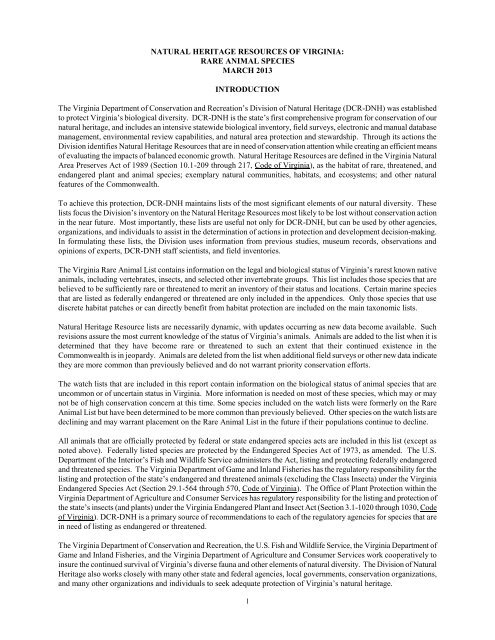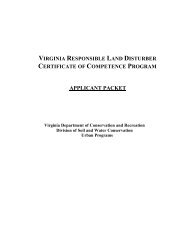Rare Animals - Virginia Department of Conservation and Recreation ...
Rare Animals - Virginia Department of Conservation and Recreation ...
Rare Animals - Virginia Department of Conservation and Recreation ...
Create successful ePaper yourself
Turn your PDF publications into a flip-book with our unique Google optimized e-Paper software.
NATURAL HERITAGE RESOURCES OF VIRGINIA:<br />
RARE ANIMAL SPECIES<br />
MARCH 2013<br />
INTRODUCTION<br />
The <strong>Virginia</strong> <strong>Department</strong> <strong>of</strong> <strong>Conservation</strong> <strong>and</strong> <strong>Recreation</strong>’s Division <strong>of</strong> Natural Heritage (DCR-DNH) was established<br />
to protect <strong>Virginia</strong>’s biological diversity. DCR-DNH is the state’s first comprehensive program for conservation <strong>of</strong> our<br />
natural heritage, <strong>and</strong> includes an intensive statewide biological inventory, field surveys, electronic <strong>and</strong> manual database<br />
management, environmental review capabilities, <strong>and</strong> natural area protection <strong>and</strong> stewardship. Through its actions the<br />
Division identifies Natural Heritage Resources that are in need <strong>of</strong> conservation attention while creating an efficient means<br />
<strong>of</strong> evaluating the impacts <strong>of</strong> balanced economic growth. Natural Heritage Resources are defined in the <strong>Virginia</strong> Natural<br />
Area Preserves Act <strong>of</strong> 1989 (Section 10.1-209 through 217, Code <strong>of</strong> <strong>Virginia</strong>), as the habitat <strong>of</strong> rare, threatened, <strong>and</strong><br />
endangered plant <strong>and</strong> animal species; exemplary natural communities, habitats, <strong>and</strong> ecosystems; <strong>and</strong> other natural<br />
features <strong>of</strong> the Commonwealth.<br />
To achieve this protection, DCR-DNH maintains lists <strong>of</strong> the most significant elements <strong>of</strong> our natural diversity. These<br />
lists focus the Division’s inventory on the Natural Heritage Resources most likely to be lost without conservation action<br />
in the near future. Most importantly, these lists are useful not only for DCR-DNH, but can be used by other agencies,<br />
organizations, <strong>and</strong> individuals to assist in the determination <strong>of</strong> actions in protection <strong>and</strong> development decision-making.<br />
In formulating these lists, the Division uses information from previous studies, museum records, observations <strong>and</strong><br />
opinions <strong>of</strong> experts, DCR-DNH staff scientists, <strong>and</strong> field inventories.<br />
The <strong>Virginia</strong> <strong>Rare</strong> Animal List contains information on the legal <strong>and</strong> biological status <strong>of</strong> <strong>Virginia</strong>’s rarest known native<br />
animals, including vertebrates, insects, <strong>and</strong> selected other invertebrate groups. This list includes those species that are<br />
believed to be sufficiently rare or threatened to merit an inventory <strong>of</strong> their status <strong>and</strong> locations. Certain marine species<br />
that are listed as federally endangered or threatened are only included in the appendices. Only those species that use<br />
discrete habitat patches or can directly benefit from habitat protection are included on the main taxonomic lists.<br />
Natural Heritage Resource lists are necessarily dynamic, with updates occurring as new data become available. Such<br />
revisions assure the most current knowledge <strong>of</strong> the status <strong>of</strong> <strong>Virginia</strong>’s animals. <strong>Animals</strong> are added to the list when it is<br />
determined that they have become rare or threatened to such an extent that their continued existence in the<br />
Commonwealth is in jeopardy. <strong>Animals</strong> are deleted from the list when additional field surveys or other new data indicate<br />
they are more common than previously believed <strong>and</strong> do not warrant priority conservation efforts.<br />
The watch lists that are included in this report contain information on the biological status <strong>of</strong> animal species that are<br />
uncommon or <strong>of</strong> uncertain status in <strong>Virginia</strong>. More information is needed on most <strong>of</strong> these species, which may or may<br />
not be <strong>of</strong> high conservation concern at this time. Some species included on the watch lists were formerly on the <strong>Rare</strong><br />
Animal List but have been determined to be more common than previously believed. Other species on the watch lists are<br />
declining <strong>and</strong> may warrant placement on the <strong>Rare</strong> Animal List in the future if their populations continue to decline.<br />
All animals that are <strong>of</strong>ficially protected by federal or state endangered species acts are included in this list (except as<br />
noted above). Federally listed species are protected by the Endangered Species Act <strong>of</strong> 1973, as amended. The U.S.<br />
<strong>Department</strong> <strong>of</strong> the Interior’s Fish <strong>and</strong> Wildlife Service administers the Act, listing <strong>and</strong> protecting federally endangered<br />
<strong>and</strong> threatened species. The <strong>Virginia</strong> <strong>Department</strong> <strong>of</strong> Game <strong>and</strong> Inl<strong>and</strong> Fisheries has the regulatory responsibility for the<br />
listing <strong>and</strong> protection <strong>of</strong> the state’s endangered <strong>and</strong> threatened animals (excluding the Class Insecta) under the <strong>Virginia</strong><br />
Endangered Species Act (Section 29.1-564 through 570, Code <strong>of</strong> <strong>Virginia</strong>). The Office <strong>of</strong> Plant Protection within the<br />
<strong>Virginia</strong> <strong>Department</strong> <strong>of</strong> Agriculture <strong>and</strong> Consumer Services has regulatory responsibility for the listing <strong>and</strong> protection <strong>of</strong><br />
the state’s insects (<strong>and</strong> plants) under the <strong>Virginia</strong> Endangered Plant <strong>and</strong> Insect Act (Section 3.1-1020 through 1030, Code<br />
<strong>of</strong> <strong>Virginia</strong>). DCR-DNH is a primary source <strong>of</strong> recommendations to each <strong>of</strong> the regulatory agencies for species that are<br />
in need <strong>of</strong> listing as endangered or threatened.<br />
The <strong>Virginia</strong> <strong>Department</strong> <strong>of</strong> <strong>Conservation</strong> <strong>and</strong> <strong>Recreation</strong>, the U.S. Fish <strong>and</strong> Wildlife Service, the <strong>Virginia</strong> <strong>Department</strong> <strong>of</strong><br />
Game <strong>and</strong> Inl<strong>and</strong> Fisheries, <strong>and</strong> the <strong>Virginia</strong> <strong>Department</strong> <strong>of</strong> Agriculture <strong>and</strong> Consumer Services work cooperatively to<br />
insure the continued survival <strong>of</strong> <strong>Virginia</strong>’s diverse fauna <strong>and</strong> other elements <strong>of</strong> natural diversity. The Division <strong>of</strong> Natural<br />
Heritage also works closely with many other state <strong>and</strong> federal agencies, local governments, conservation organizations,<br />
<strong>and</strong> many other organizations <strong>and</strong> individuals to seek adequate protection <strong>of</strong> <strong>Virginia</strong>’s natural heritage.<br />
1
















